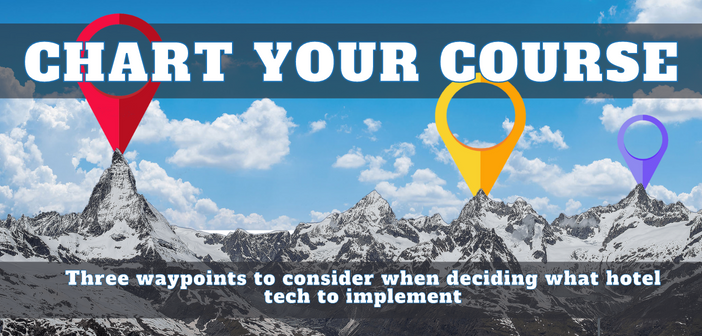Three waypoints to consider when deciding what hotel tech to implement
As is noted multiple times throughout this issue, technology is the only way forward for hotels. One way or another, every company will continue to innovate to increase team productivity or improve the guest experience. The problem, though, is that time is an exceedingly rare commodity.
During the past few years, every hotelier has been pressed to the wall. Frontline labor is hard to find and harder to maintain. Managers have limited bandwidth while also having to continually shift their focus amongst an ever-widening series of tasks. Executives are struggling to contend with an uncertain future as the world bounces from one crisis to another. And let’s not forget how “The Great Resignation” has left a slew of vacancies in senior positions, hindering decision making. All the while, there are innumerous tech vendors, many with overlapping feature sets, vying for your eyes and ears, together creating a cacophony of digital noise.
This paints a picture of doom and gloom, but market forces at play indicate the opposite to be true. The future of travel is bright, and the plethora of tech vendors at your disposal simply means there’s now a solution for whatever problem you have. It’s more a matter of defining your priorities as well as your process for evaluating the resolutions to those priorities.
Even as we navigate the unpredictable and seemingly exhausting landscape of possibilities hoping for budget dollars in 2023, there are nevertheless a handful of principles through which to ground your decision making when it comes to technology implementation.
To keep it concise, here are just three principles that have been applied time and again to any of our “Teams and Tech Audits” or any strategic consulting assignment we undertake. While we have developed these core tenets internally, they have also been shaped and reinforced from an interview with Anil Taneja, managing director of Palm Holdings, an owner and operator group with a diverse portfolio of 25 flagged and independent hotels in the United States, Canada, and the United Kingdom.
 Principle #1
Principle #1
YOUR TEAM ALWAYS COMES FIRST
For most organizations, whether in the hotel industry or not, the biggest obstacle often is churn. If you constantly have to recruit and train associates or bring new managers up to speed, you won’t have time to innovate. Your company will be left spinning, which often leads to a positive feedback loop – overworked and stressed-out teams resulting in even more turnover. This problem also seeps into the IT department where, nowadays, a single team member quitting can delay a full quarter of rollouts.
Hence, you need to fight for your people. Technology can profoundly help in this regard by helping digitalize the repetitive, interruptive, boring, time-consuming, and demoralizing aspects of the job. But, make no mistake, automation doesn’t allow you to replace team members with artificial intelligence; it lets you redirect your managers and staff toward more complex tasks and the meaningful work that will keep them engaged.
On this note, Taneja added, “Any technology is as good as the user. We need to make sure our team believes and is capable of using it. The training, follow up, and the user are even more important than the technology itself.”
Innovation with the goal of increasing team retention isn’t just for the realm of tech, though. You need good policies in place that create a work environment where people actually want to stick around. Don’t think about corporate culture so much as corporate community. Start with good staff meals, since those who eat together stay together. How do you celebrate your team as well as their personal milestones? Do you organize team-building offsite? Are you innovating in the area of employee mental health – a consequence of the pandemic that’s just now receiving widespread awareness? How are you helping improve your team’s physical health, even if it’s something as simple as weekly stretching classes?
Whether or not it expressly involves tech, anything and everything must be considered so you aren’t constantly playing catch-up.
 Principle #2
Principle #2
DEEPEN EXISTING RELATIONSHIPS WHEREVER POSSIBLE
Having overseen several PMS migrations through our tech consulting assignments for hotels, we can tell you that any large-scale hardware or core software changeover is as difficult as passing a kidney stone. It takes months to evaluate, an equal time to execute, then even more to bring your teams fully up to speed. All told, when you factor in the opportunity costs of lost time, it often isn’t worth it.
Moreover, you have two other time-related factors when considering anything new. The first is the strain on your IT team. Every tech vendor has an open API (application programming interface) and can provide an SDK (software development kit) for coding that connection, but this still means that someone on the hotel side is required to block off a half-day chunk, or longer, to complete the work. If your IT professionals are already stretched thin by having to maintain existing systems, this project will lag and you won’t have the necessary data connections to make it all seamless.
Secondly is the problem of what we call “zombie platforms.” These are pieces of software that are purchased and onboarded but then no one on your team has time to use on a daily basis because they already have a dozen other windows to look at while at their terminal. As a sidenote, humans are inherently horrible at multitasking – that is, it’s time-inefficient, not to mention stress-inducing.
These three issues mean your first move should be to look for ways to better use what you already have. Still, it would also help to establish a set of deal-breakers so you have a proverbial line in the sand for when you know it’s time to move on, however painful that move may be.
For any migration, or when opting to deepen your utilization of any existing supplier’s features, it’s vital to look for vendors that can solve your most salient problems but then also have room to grow. For example, do they offer additional modules or tools that could be onboarded in subsequent business cycles to resolve other challenges you may be facing? Additionally, always look for companies with great technical support because, to restate the first principle, if the vendor is suffering from churn, you’ll ultimately end up on the receiving end of their internal grief.
 Principle #3
Principle #3
LOOK FOR SOFT INNOVATIONS
The very word “innovation” insinuates some ephemeral vision of sweeping transformation and revolutionizing the way people interact. This is malarkey; it never works that way. Technology and process improvements in actuality occur on a gradual basis, rife with workarounds and tradeoffs.
In the moment, it can all feel as if things are progressing at a glacial pace, so it’s important to establish milestones and KPIs to reflect on what’s been done and where the goalpost has been moved. In its own right, the action of designing what to measure can help to focus your teams on what really matters.
This form of innovation isn’t “hard,” in that an executive can point to a specific new software tool or onsite device that’s been deployed. Rather, it’s “soft” because it pertains to the intangibles and to how your teams interact to push the needle forward. Frequently, the soft is more powerful than the hard.
“Labor today is smarter than ever before. They don’t want to process data; they want to influence data,” Taneja said. “They want to be empowered with information and be part of the hotel’s growth. Hospitality’s labor pool will continue to decrease at a faster pace than other industries until we involve our front of the line in more decisions. We have to compete with other industries when it comes to empowering and growing our teams, which is something the hotel industry has always fallen behind in.”
However, when involving front-line employees in decisions, it’s crucial to avoid groupthink within hotel organizations. Do you really need six managers to sit in on a meeting when the only ones talking are the two direct project leads? Moreover, does the meeting even need to happen when an email will suffice? For even more efficiency, why use an email thread when you can compartmentalize tasks and assignees on a collaboration platform like Slack or Asana?
This is all back-of-house time management, which then simultaneously ramps up team productivity and increases morale by reducing the stress of having to multitask across different systems or constantly being interrupted by ongoing email conversations. Next, apply this type of soft empowerment to your guest-facing policies and you undoubtedly will experience tremendous success with whatever tech path you chart in the year ahead.
ALL IN SERVICE TO THE STAKEHOLDERS
The common theme among the three principles discussed here is that no matter the technology being implemented, it always comes down to the people behind the scenes – both those who set up and onboard the tech as well as those using it on a daily basis. Moreover, to round out the whole pie of stakeholders, you must consider not only the IT department and your frontline teams but also any other B2B and B2C relationships that are impacted by technological developments.
Taneja said it best when he added, “At Palm Holdings, as we continue to grow and expand, our commitment remains unchanged. We seek to provide exceptional service to our customers and to value all stakeholders with our business. That commitment has led to us repeating business with everyone we work with. We want to foster all relationships and grow alongside our suppliers and customers. Our success is because of these relationships. They are the pillars holding us up every day through the hard times and the good times.”






